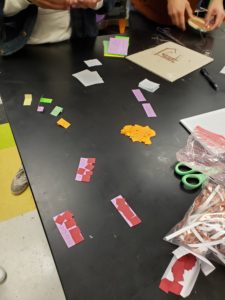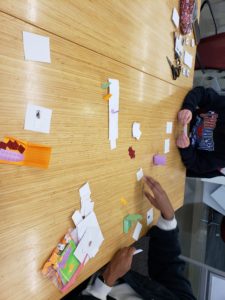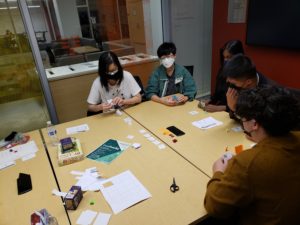Goutham and Vicky’s P1: Those who play, teach. Presenting, ‘The Warblers’!
Overview
The Warblers is a game intended to teach 3-6 players about the nature and effect of invasive species on ecosystems. The game is competitive, with each player playing as either a native or invasive species of warbler on a single tree. The invasive species aims to dominate the ecosystem and become naturalized into the environment while the native species aim to remove the invasive species from the ecosystem. The game aims to demonstrate the amount of effort it takes to stop invasive species from destroying other species within its ecological niche and how quickly invasive species can take over a habitat.
The game involves strategy and decision making as each player aims to optimize their actions to both remain populous as a species while trying to prevent the invasive species from growing as well. All warblers have a variety of distinctive characteristics that other species can use to identify each other and instigate events to affect their population. The native species need to cooperate in order to defend their ecosystem and identify the invasive species while the invasive species needs to hide information about itself and grow its population. This cooperation requires individual species to sometimes sacrifice their own wellbeing in order to prevent the invasive species from growing. This promotes discussion among players and a sense of the compromises and environmental damages that invasive species instigate.
By the end of the game, players should recognize the challenges of removing an invasive species and how species become naturalized in an environment. As ecological concepts are incorporated through gameplay, this game allows players to relate to the ongoing struggles between competing species within an environment.
Rules
Story Background:
In this giant tree in the middle of the forest, the warblers have lived in ecological harmony for as long as they can remember. But one day, a new warbler species joins their number. It turns out to be an invasive species! The invasive species is now competing with the other warblers for resources and trying to become established in the tree.
As a native warbler, work with other warblers to figure out what characteristics the invasive has, to target and get rid of the invasive to restore balance to your tree.
As the invasive warbler, this tree is the perfect space for you and your future kin. Outcompete the other warblers and increase your population large enough to become established in the tree.
Set up:
Place the shuffled event cards stack and food stack in the middle. Each player will draw a random bird card that they will keep to themselves. Next, every player will get a nest, a player piece, and 5 population tokens to start. Afterwards, grab the role cards. Depending on the number of players, keep the invasive card in and the rest native cards. Each player will then draw a role card without looking. Once role cards are drawn, each player will place their role cards face up so that other players can see. The chosen invasive player then decreases their population to 3 population tokens.
Players will place their population tokens into their nest in order to hide the number of tokens and players should ensure that other players cannot see their bird species. Players will place the event card deck into the center of the table and draw five event cards and place them where all the players can see.
Gameplay:
Native warblers are trying to stay alive and figure out the invasive warbler’s identity. They can use event cards to try to take out the invasive before they reach the population goal of 10.
Invasive warbler is trying to use the event cards to increase their population and take out the other warblers. The Invasive wins when it reaches 10 population.
Players will take turns going in a clockwise direction from the invasive player, starting with the invasive player. At the start of the player’s turn they take one food token and take one action.
Potential Actions:
- Take an additional food
- Spend food to start an event
- Replace an event card following any potential replacement rules on the card
- Spend 2 food to increase their population by 1
During the invasive’s turn, they also increase their population by 1 and take an additional food.
Event Cards:
When players activate an event card, they pay the food cost (returning the food to the food stack) and the rules on the card are put into effect. All players that are affected have to follow the instructions. After the card is in effect, put it in the discard pile and draw a new event card to ensure there are 5 events available.
The game ends when either the invasive reaches 10 population or when the native species use event cards to get the invasive species to 0 population.
Game Bits
The game consists of bird cards, native/invasive cards, food tokens, population tokens, nests, event cards, reference sheet and player pieces
Bird cards (8)
- Bird cards that provide players information about their bird
- Each card is based on a real warbler species, giving the picture, common name, range, color, scientific name, region, and nesting area
Role cards (6)
- This card determines whether the player is an invasive or a native species of warbler. Depending on the number of players, only one of the cards would be invasive and the rest native
Food tokens (48)
- Food tokens represent food that players use to trade in for event cards
Population tokens (60)
- Tokens that represent population for each bird. One token is one population
Nests (6)
- ‘Nests’ are paper containers each player can use to hide their population and amount of food in, so that other players will not see what they have
Event cards(37)
- The event cards affect the player’s food, population, etc based on the warbler they are playing as
- Each event targets species with distinctive characteristics that enable players to figure out each other’s species and decrease each other’s population
- Each card has a particular food cost that needs to be paid for it to activate
- Each warbler has a list of distinctive characteristics that lead them to be affected by particular events
Reference sheet
- Sheet that shows all 8 warbler species information that is on the bird cards
- Players can use this as reference to figure out which player is which warbler
Player pieces(6)
- Bird stand for each player to represent their bird
Assessment
Our assessment of our learning goals consisted of questions about invasive species and warblers before and after the gameplay. Many of our players had heard of the concept of invasive species but did not know many details about their interactions with other species in an environment. After we finished the game we asked players about invasive species to see whether they had changed their answers or impressions. In general, players recognized the challenges in fighting off invasive species and recognized how the game mechanics applied to the scenario we painted. In the future we want to have various details (or expansion packs!) which provide more detailed information about invasive species and give players handy references to learn more explicitly about invasive species.
We also conducted a brief informational session about warblers after the playtests with players to inform them about the unique ways in which warblers coexist in trees though they might occupy the same ecological niche. These info sessions held the players’ attention and seemed to intrigue them. In the future we hope to also provide a more concrete set of information about the warblers and give players these details through a handbook or a digital guide to other online resources.
History
For our game we conducted three different playtests and changed the game drastically between the playtests.
Version 1:
Originally, our game was intended to be a social deduction game where the birds would keep their invasive or native status hidden. The goal of the invasive species was to remain hidden and reach 10 population tokens while the native species aimed to figure out which species was invasive and target that species once they found it. The players still had to maintain their population and the event cards remained largely the same but the food tokens were used in a “night phase” where each player would pick up food and the invasive species would steal from another player. There would then be a day phase where players would pick between 3 events to enact that day in order to try and either find out the invasive species or to decrease its population.
We playtested this version with both Vicky and Goutham along with our friend Kelly and the Makery mentor Aaron.
This version of the game had a number of issues:
- The food-to-population transition was complicated and confusing to players as they weren’t sure when to pick up population or food
- The night phase was difficult to manage since the players needed a moderator to actually tell them when to open their eyes
- The events felt disconnected from the game as the discussion was based off very little information since they didn’t know what each other’s differentiating characteristics were

Version 1 Playtest
Version 2:
As a result, we ended up going back to the drawing table to try and figure out how to simplify the gameplay. We decided that the night phase was far too complicated and that instead of having multiple food tokens, players would each get one food token and the invasive would just take another player’s food token so that in the morning they would know whether they had to gain or lose population. In order to make the players feel more engaged with the events, we decided to give players events to have a “hand” of events that could be played. Each round they could play an event and then have it resolve itself. Unfortunately, this version of the game wasn’t completely thought through as it still was very confusing for players to navigate the night phase. Also the lack of information between players was an issue since it was too difficult to figure out what would affect different players.
We playtested this version with Vicky, Goutham, and Cynthia from the study group.

Version 3:
We realized that the fun of our game wasn’t that players enjoyed trying to figure out who the invasive species was. Rather, the fun came from using the event cards to try and affect each other’s population. The gameplay around the different characteristics and population management was really interesting for players but it was lost beneath the complexity. To fix that, we decided to remove the social deduction part of the game involving finding out the invasive species and instead, focusing on finding out what kind of bird the invasive species was. We made a reference sheet and made it so the invasive species was public knowledge but the characteristics of their bird were hidden. We also brought back the original gameplay where there were event cards open in the middle of the table and players discussed which to implement. The players also had food tokens as resources they could spend to activate one of five events. This version felt very good to play as the players talked through the best cards to use and were very strategic with their food tokens. In addition, it felt like the invasive species was a tall challenge and they had to work together to try and have a shot at beating it.
We played with Melody, Katherine, Thomas, Eugene, and Kavita.

Playtest v3
Play At Home!
Bird Reference Sheet – use this and paste the information onto index cards!
Bird Tokens & Population Tokens – Cut up colored pieces of paper to serve as tokens
Nest – Fold the nest with an index card




Interesting idea! The “night phase” in the earlier version is reminiscent of mafia!
The documentation could be a bit clearer when it comes to explaining the visibility of the invasive species player to other players. In the final version, are people able to see who is representing the invasive species, but unable to see the survival traits of this species (e.g. what food it eats, etc)? Or do they need to figure out everything about the invasive player, from the identity to the species characteristics?
I wonder if a version where the native players are slowly “turned into” invasive species would add even more excitement to the game!
Nice work overall.